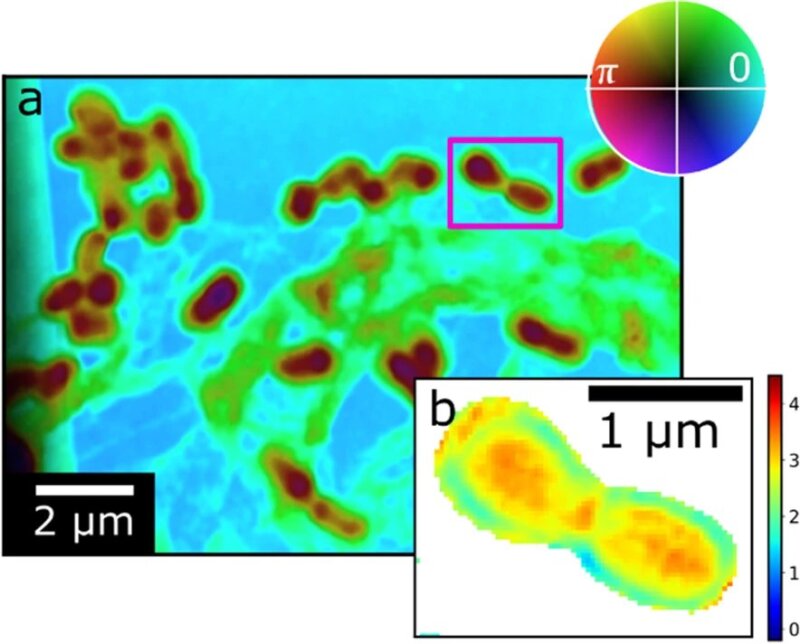- Light
- Life
- Forschung
Published: | By: Ira Winkler
High-resolution EUV ptychography reconstruction of E. coli bacteria
Picture: C. Liu et al.In order to develop more targeted cures for diseases, precise knowledge of the different stages in the development of pathogens and their interaction with infected cells is required. Extreme ultraviolet (EUV) light with a very short wavelength is particularly suitable for this, as it allows microscopy with a very high resolution (sub-20 nm).
Now, the interdisciplinary team led by Dr. Jan Rothhardt1 has been able to examine complex microbiological samples, specifically seedlings of the fungus Aspergillus nidulans and Escherichia coli bacteria, using a novel high-resolution lensless microscope that works with extreme ultraviolet (EUV) light. This made it possible, for example, to identify the tip body of A. nidulans and the chemical composition of the cell wall of E. coli bacteria at different stages of cell division [1].
"Due to the high elemental contrast of the EUV radiation and an exceptionally high spatial resolution, subcellular structures of the two model organisms can be identified and subsequently assigned to known organelles," says Dr. Falk Hillmann2, impressed. His team selected the biological model samples and developed a suitable preparation method on EUV-transparent silicon nitrite membranes.
But how exactly does this new type of imaging work and what technical innovations were needed?
A novel EUV microscope adapted to the source was realized in my working group. It is based on the ptychography method, a special form of computer-assisted, lensless imaging [2]. The microscope is the first to use structured EUV illumination, which is crucial for high resolution and excellent image quality [3].
In this context, structured means that the EUV radiation used to illuminate the sample is shaped by a special illumination mask.
This mask is designed to transfer certain structures in the nanometer range to the EUV radiation. These can be patterns, lines or other shapes, which are then projected onto the biological sample. The structured EUV exposure plays a decisive role in the microscope's high resolution and excellent image quality," explains Dr. Rothhardt.
The illumination mask is essential for the resolution and image quality of the microscopic image. Prof. Thomas Pertsch3, who has driven its development, emphasizes: "The production of this EUV mask requires the highest precision. A process has been developed with which absorbing binary EUV masks can be produced on the basis of thin metal foils. The nanostructuring was applied to the masks using a focused ion beam. By combining these nanostructured masks, the unique EUV light source and the novel EUV microscope, we were able to achieve a record resolution of 16 nm and demonstrate this in a resolution test [3]. Since the EUV microscope provides quantitative amplitude and phase information in each image pixel, it is even possible to identify the chemical composition on the nanoscale."
The compact EUV light source required for this was developed under the leadership of Prof. Jens Limpert's4 working group. Laser-driven coherent EUV light sources on a laboratory scale have undergone rapid development in recent years. Record performances have already been demonstrated at the Institute of Applied Physics, which are comparable to synchrotron beam sources in some areas of EUV [4]. However, the laser-driven EUV light sources from Jena can be operated more cost-effectively and are compact and portable. Both are key application advantages over large-scale synchrotron research facilities.
Expanding possibility of applications & accessibility
"The new extreme ultraviolet (EUV) method enables high-resolution imaging of biological samples in an entirely new way," says Prof. Limpert, emphasizing the importance of this scientific milestone: "The interdisciplinary collaboration has enabled us to create a compact EUV microscope on a laboratory scale and demonstrate it on microorganisms. This not only expands the possible applications, but also makes the technology more accessible."
This special interdisciplinary collaboration across the top research institutes at Beutenberg was honored on 15.11.2023 with the Science Prize of the Beutenberg Campus Jena e.V., which was awarded for the first time in the category "Excellent interdisciplinary cooperation". "This award highlights exactly what the campus lives for and makes it special: cutting-edge research with outstanding application relevance beyond disciplinary boundaries, in other words "...where life science meets physics!", says Dr. Christiane Meyer, Scientific Officer of the Beutenberg-Campus e.V., delightedly.
------------------------
1 Dr. Jan Rothhardt, Soft X-ray Spectroscopy and Microscopy, Institut für Angewandte Physik (IAP) & Helmholtz Institut Jena
2 Dr. Falk Hillmann, Evolution Mikrobieller Interaktionen, Leibniz-Hans-Knöll-Institut, Jena
3 Prof. Thomas Pertsch, Nano & Quantum Optics, IAP, Friedrich Schiller University Jena
4 Prof. Jens Limpert, Fiber & Waveguide Lasers, IAP & Fraunhofer IOF
[1] C. Liu, W. Eschen, L. Loetgering, D. S. Molina, R. Klas, A. Iliou, M. Steinert, S. Herkersdorf, A. Kirsche, T. Pertsch, F. Hillmann, J. Limpert, and J. Rothhardt, "Visualizing the ultra-structure of microorganisms using table-top extreme ultraviolet imaging," PhotoniX 2023 4:1 4(1), 1–15 (2022).
[2] P. Thibault, M. Dierolf, A. Menzel, O. Bunk, C. David, and F. Pfeiffer, "High-resolution scanning x-ray diffraction microscopy.," Science 321(5887), 379–82 (2008).
[3] W. Eschen, L. Loetgering, V. Schuster, R. Klas, A. Kirsche, L. Berthold, M. Steinert, T. Pertsch, H. Gross, M. Krause, J. Limpert, and J. Rothhardt, "Material-specific high-resolution table-top extreme ultraviolet microscopy," Light: Science & Applications 2022 11:1 11(1), 1–10 (2022).
[4] R. Klas, A. Kirsche, M. Gebhardt, J. Buldt, H. Stark, S. Hädrich, J. Rothhardt, and J. Limpert, "Ultra-shortpulse high-average-power megahertz-repetition-rate coherent extreme-ultraviolet light source," PhotoniX 2(1), 1–8 (2021).
